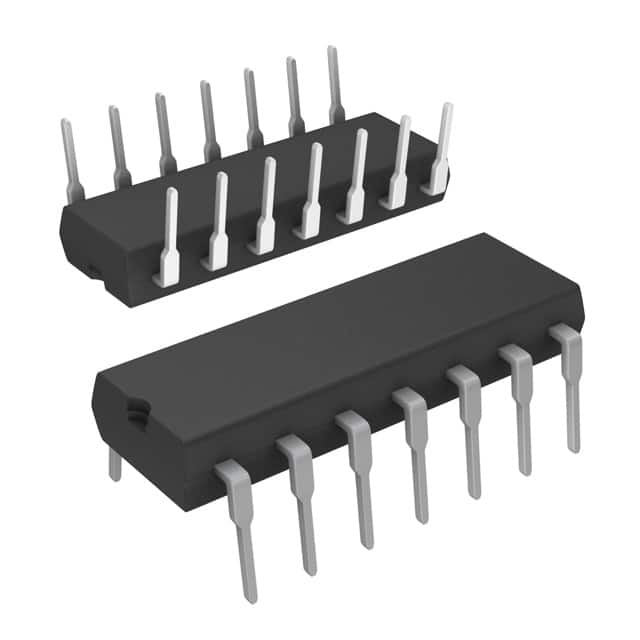Xem thông số kỹ thuật để biết chi tiết sản phẩm.

LM319N
Product Overview
Category: Integrated Circuit (IC)
Use: LM319N is a high-speed dual comparator designed for use in applications requiring fast response times. It is commonly used in electronic circuits to compare two voltage inputs and provide a digital output based on the comparison result.
Characteristics: - High-speed operation - Wide input voltage range - Low input offset voltage - Low input bias current - Open collector outputs for easy interfacing - Wide supply voltage range
Package: LM319N is available in a 14-pin DIP (Dual In-line Package) format, which provides ease of installation and compatibility with standard IC sockets.
Essence: The essence of LM319N lies in its ability to quickly and accurately compare voltage inputs, making it suitable for various applications that require precise voltage monitoring and control.
Packaging/Quantity: LM319N is typically sold in reels or tubes containing multiple units. The exact quantity may vary depending on the supplier.
Specifications
- Supply Voltage Range: 5V to 36V
- Input Offset Voltage: ±2mV (maximum)
- Input Bias Current: ±25nA (maximum)
- Response Time: 0.3μs (typical)
- Output Current: 20mA (maximum)
- Operating Temperature Range: -40°C to +85°C
Pin Configuration
LM319N features a 14-pin DIP package with the following pin configuration:
```
| | --| IN(-) 1|-- VCC+ --| IN(+) 2|-- OUT --| GND 3|-- NC --| OUT 4|-- IN(-) --| VCC- 5|-- IN(+) --| NC 6|-- GND --| IN(-) 7|-- OUT --| IN(+) 8|-- VCC+ --| GND 9|-- NC --| OUT 10|-- IN(-) --| VCC- 11|-- IN(+) --| NC 12|-- GND |__________| ```
Functional Features
- High-Speed Operation: LM319N offers fast response times, making it suitable for applications that require quick voltage comparisons.
- Wide Input Voltage Range: The comparator can handle a wide range of input voltages, allowing flexibility in various circuit designs.
- Low Input Offset Voltage: LM319N exhibits minimal voltage difference between the two inputs when they are equal, ensuring accurate comparisons.
- Low Input Bias Current: The comparator draws very low current from the input sources, minimizing any potential impact on the circuit's performance.
- Open Collector Outputs: The open collector outputs simplify interfacing with other digital circuits or devices.
- Wide Supply Voltage Range: LM319N operates over a broad range of supply voltages, providing versatility in different power supply configurations.
Advantages and Disadvantages
Advantages: - High-speed operation enables rapid voltage comparisons. - Wide input voltage range allows for versatile application possibilities. - Low input offset voltage ensures accurate comparisons. - Open collector outputs facilitate easy integration with other circuits. - Wide supply voltage range provides flexibility in power supply options.
Disadvantages: - Limited number of comparators (dual) in a single package. - Requires external components for specific applications. - Not suitable for precision voltage measurements due to limited accuracy.
Working Principles
LM319N works based on the principle of comparing two input voltages and producing a digital output based on their relationship. When the voltage at the non-inverting input (+) is higher than the voltage at the inverting input (-), the output goes high. Conversely, when the voltage at the inverting input is higher, the output goes low.
The comparator's internal circuitry amplifies and compares the input voltages, utilizing a differential amplifier configuration. The output stage consists of open collector transistors that can sink current when the output is low.
Detailed Application Field Plans
LM319N finds applications in various fields where fast and accurate voltage comparisons are required. Some common application areas include:
- Analog-to-Digital Converters (ADC): LM319N can be used as a front-end comparator in ADC circuits to convert analog signals into digital data.
- Voltage Level Detection: It can be employed to detect voltage levels in power supply circuits, ensuring proper operation and protection against overvoltage or undervoltage conditions.
- Signal Conditioning: LM319N can be utilized in signal conditioning circuits to compare and process different voltage levels for further analysis or control.
- Motor Control: It can be integrated into motor control systems to monitor and compare feedback voltages, enabling precise speed and position control.
- **Window Comparators
Liệt kê 10 câu hỏi và câu trả lời thường gặp liên quan đến ứng dụng LM319N trong giải pháp kỹ thuật
Sure! Here are 10 common questions and answers related to the application of LM319N in technical solutions:
Q: What is LM319N? A: LM319N is a high-speed dual comparator integrated circuit (IC) commonly used in various technical applications.
Q: What is the operating voltage range for LM319N? A: The operating voltage range for LM319N is typically between 5V and 30V.
Q: What is the maximum input offset voltage of LM319N? A: The maximum input offset voltage of LM319N is typically around 7mV.
Q: Can LM319N operate in a single-supply configuration? A: Yes, LM319N can be operated in a single-supply configuration by connecting the negative supply pin (V-) to ground.
Q: What is the typical response time of LM319N? A: The typical response time of LM319N is around 1.3 microseconds.
Q: Can LM319N be used as a voltage comparator? A: Yes, LM319N is primarily designed for voltage comparison applications.
Q: Does LM319N have an open-drain output? A: No, LM319N does not have an open-drain output. It provides push-pull outputs.
Q: What is the maximum supply current required by LM319N? A: The maximum supply current required by LM319N is typically around 2.5mA.
Q: Can LM319N tolerate overvoltage on its inputs? A: No, LM319N is not designed to tolerate overvoltage on its inputs. Exceeding the specified voltage range may damage the IC.
Q: What are some common applications of LM319N? A: LM319N is commonly used in applications such as window comparators, voltage level detectors, pulse-width modulators, and analog-to-digital converters.
Please note that the answers provided here are general and may vary depending on specific datasheet specifications and application requirements.

